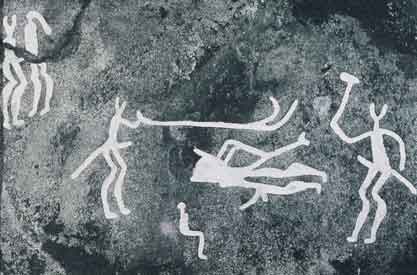“Unnatural!” is the homophobes’ most common invective. We are called “freaks of nature” and a “biological error.” How can they believe this? To see homosexuality as unnatural, they need to stay completely unfamiliar with the world outside – or within – where homosexuality is as common as dirt.

Sweden, sacred rock carving of animal-people with tails, antlers and erections
The nature homophobes imagine is simple and desolate. It reflects only their own limited options. They think animals and even plants are always either male or female, and driven by a reproductive imperative. They dream that each species is bent on competition, engaged in a battle for survival that pits every life form against each other. They describe animals as if they have no moral life, no capacity for feeling or communication, and of course, no homosexuality. It is a view that would have nature mirror the social regime of contemporary society, while it justifies the pillage of an insensate earth.
We can meet these homophobic stereotypes with plenty of evidence of homosexuality in nature. But more importantly, we can see that homosexuality invites us to a radically different understanding of natural systems. When we see that queer is nature, then nature is polysexual and exuberant. The nuclear family is not the inevitable model for love and breeding. Queer evokes archetypes of cross-species sexuality and animal ancestors, admitting a world of nature that is emotionally complex and culturally intricate. We can create queer as a lived understanding of biological diversity.
Through homosexuality we are invited to live in a world ordered by kinship and transformation. The capacity for transformation, that brings us from expected modes of life to something fabulous, also brings us into alignment with the transforming world – its seasonal cycles, flowing rivers, dramas of birth and rebirth. Queer means we challenge borders and erase boundaries that prevent us from becoming one another. Sustaining ourselves and each other, we fit into a complicated web of lifeforms. We transform the established patterns, seek new habitats an abandon some, live and thrive where it seems we cannot. The extraordinary persistence of same-sex passions, throughout history and around the world, is evidence not of evolution, but of magic.
Shadow: We may be tempted to meet the wounding homophobic stereotypes by claiming a counter-stereotype – we are “born that way.” But we run into difficulties when we try to weave homosexuality into the culture of nature, without changing the colours and the pattern. Hence “the cause” is madly pursued. Is homosexuality an adaptation, a substitution, an aberration, a consequence? Is there a cure? Affirming the existence of homosexuality throughout nature requires a reconceptualization of natural systems.[1] It asks that we recognize multiplicity and mutability, magic and mystery.
Related Figures and Attributes: Animal, Wild Man, Witch
For more writing on this symbol, see these chapters of Orientation: Mapping Queer Meanings: Dirt, Environments, Limits, Conclusion
[1] Bruce Bagemihl, 1999, explores ways in which acknowledging the widespread existence of animal homosexuality and non-reproductive sexualities invites a radical re-thinking of the natural world.


